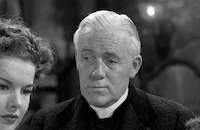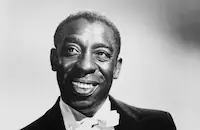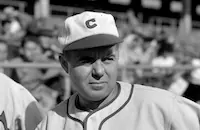Jam Session

Brief Synopsis
Cast & Crew
Charles Barton
Ann Miller
Jess Barker
Charlie Barnet
Louis Armstrong
Alvino Rey
Film Details
Technical Specs

Synopsis
At the Superba Studios in Hollywood, California, magazine writer George Carter Haven, from New York City, is hired as the new writer on a musical picture directed by Lloyd Marley. Another recent arrival to Hollywood is aspiring actress Teresa "Terry" Baxter, from Waterfall, Kansas, who has won a trip to the city in a dance contest sponsored by the Waterfall Tribune . Terry hopes that a letter of praise from the Tribune movie critic will get her an interview with studio head Raymond Stuart. Soon after taking up residence at a Hollywood boardinghouse, Terry meets George, who is also living there, and they strike up an immediate friendship. Terry's first attempt to see Stuart ends in disaster when, after being refused a meeting with him, she walks onto a set during filming and ruins a scene. Back at the boardinghouse, Terry overhears George's telephone conversation with the studio, and gets an idea to procure another studio pass by posing as his secretary. Returning to the Superba lot, Terry goes in search of Stuart, but her second visit to the studio also ends in disaster when she accidentally knocks over a water cooler on a sound stage and ruins the filming of a dance number. Terry is thrown off the sound stage and sent to George's office, where she tells the creatively blocked writer that he should add a tap dancing routine to the picture. George considers the idea, but is more interested in a story that Terry has told him, which happens to be the story of her life. Inspired by Terry's story, George hurriedly dictates his version of the story back to her. Terry, however, makes a mess of the dictation, and, as a result, causes George's dismissal. Later, Terry meets a kindly man in the park and, unaware that he is Stuart, tells him about how she got George in trouble. Terry's luck goes from bad to worse when she is arrested for breaking into a house she thought was Stuart's. Intending only to visit Stuart and explain her situation, Terry instead lands in jail and her picture is printed in the newspapers. Stuart, seeing Terry's picture and recognizing her from the park, rescues her from jail and gives her a contract with the studio. George is reinstated at his job, and he and Terry look forward to a promising future in motion pictures.

Director
Charles Barton
Cast

Ann Miller
Jess Barker
Charlie Barnet

Louis Armstrong
Alvino Rey
Jan Garber
Glen Gray
Teddy Powell
Pied Pipers
Nan Wynn

Charles D. Brown

Eddie Kane
George Eldredge
Renie Riano

Clarence Muse
Pauline Drake
Charles La Torre
Anne Loos

Ray Walker
George Carlton

George Mckay
Robert Williams
Vernon Dent
Ethan Laidlaw
Victor Travers
Charles Haefeli
Allen Fox
Eddie Hall
Eddie Bruce
Bill Shawn
Ted Mapes
Hank Bell
John Tyrrell
Terry Frost
Eddie Laughton
Paul Zaremba
Marilyn Johnson
Constance Worth
Nelson Leigh
Jay Eaton
Margaret Fealy
Ben Taggart
Thomas Kingston
Riley Thompson
Marguerite Campbell
John Dilson
Joanne Frank
Crew
William R. Anderson
Lionel Banks
Ary Barroso
Earl Bellamy
Irving Briskin
Sammy Cahn
Bill Carey
Richard Fantl
Dorothy Fields
Carl Fischer
W. C. Handy
Paul Holly
William Kiernan
Johnny Lange
Frank Loesser
Jimmy Mchugh
Patterson Mcnutt
Paul Murphy
Ray Noble
L. W. O'connell
Val Raset
Leon René
S. K. Russell
Manny Seff
M. W. Stoloff
Jule Styne
Larry Wagner
Harlan Ware
Sam White

Film Details
Technical Specs

Articles
Jam Session
Ann Miller's dance highlights in Jam Session are "No Name Jive," accompanied by Glen Gray's orchestra in its best Glenn Miller style; and "Victory Polka," with an uncredited Bill Shawn as her partner. In addition to Gray, the movie boasts a number of other celebrated big-band musicians, including Charlie Barnet's band playing its specialty, "Cherokee"; Louis Armstrong doing "I Can't Give You Anything But Love" with his orchestra; Teddy Powell and company performing "Murder He Says"; Alvino Rey's group handling "St. Louis Blues," Jan Garber's band playing "I Lost My Sugar"; vocalist Nan Wynn singing "Brazil"; and the Pied Pipers (including Jo Stafford) doing "It Started All Over Again."
In a brisk 78 minutes, the movie presents its slender storyline as the connective tissue between the musical cameos and specialty acts. Miller plays Terry Baxter, a small-town girl from Kansas who wins a trip to Hollywood and tries to find a career as a dancer, only to settle for being secretary to screenwriter George Carter Haven (Jess Barker). After mixing up some scripts and getting arrested for trying to break into a residence she mistakenly believes belongs to Haven's boss (Charles D. Brown), Terry manages to prevail, winning not only a film contract but Haven himself.
The New York Times review at the time summed up: "The Columbia Picture which came to the Palace yesterday, starring Ann Miller with a flock of name bands, rolls evenly and amusingly along on an entertaining if somewhat pre-ration story."
Barker, a leading man in many "B" movies of the 1940s and '50s, entered into a stormy 10-year marriage to superstar Susan Hayward the same year that Jam Session was released.
A brief clip from Jam Session was featured in the Monkees film vehicle Head (1968).
Producer: Irving Briskin
Director: Charles Barton
Screenplay: Manuel Seff, from story by Patterson McNutt and Harlan Ware
Cinematography: L. W. O'Connell
Film Editing: Richard Fantl
Original Music: Jule Styne
Art Direction: Lionel Banks, Paul Murphy
Cast: Ann Miller (Terry Baxter), Jess Barker (George Carter Haven), Alvino Rey and his Orchestra (Themselves), Louis Armstrong and his Orchestra (Themselves), Charlie Barnet and his Orchestra (Themselves), Jan Garber and his Orchestra (Themselves), Glen Gray and His Orchestra (Themselves), Teddy Powell and His Orchestra (Themselves), The Pied Pipers (Themselves), Charles D. Brown (Raymond Stuart).
BW-77m.
by Roger Fristoe

Jam Session
Quotes
Trivia
Miscellaneous Notes
Released in United States Spring April 13, 1944
Selected in 2001 for inclusion in the Library of Congress' National Film Registry.
Released in United States Spring April 13, 1944













